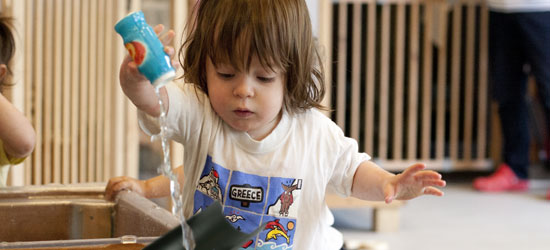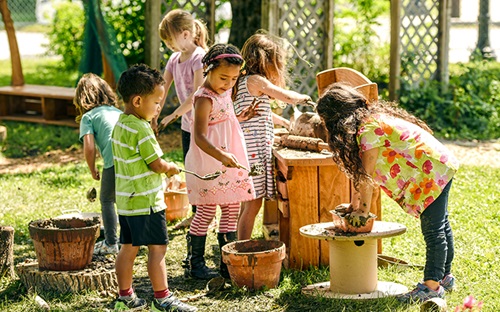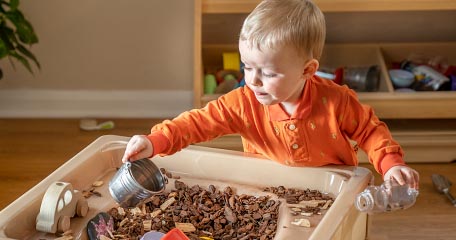Playing in the gutters
Enhancing children's cognitive and social play
| May 2012Traditionally the sand area has provided opportunities for manipulation, construction, and discovery as children experiment with pouring, digging, and mixing sand with water.
Last year we enriched our sand area with the introduction of plastic rain gutters. By our providing this simple but engaging medium to expand upon learning in our nursery school program for children ages two-and-one-half to five, a whole curriculum emerged, stimulating cognitive development as well as fostering cooperation, communication, and dramatic play.
We introduced the gutters at the beginning of the spring quarter. To our surprise the children’s interest did not wane throughout the entire 11 weeks. The gutters became a permanent part of our daily set-up, although the children constantly rearranged them as they worked on their own problems. The rain gutters remained a focal interest during free-choice play.

Obtaining the material
Plastic gutters are available at building-supply and lumber stores, where they are normally sold to attach to roofs as rain gutters. Inexpensive and lightweight, their smooth, curved surfaces have no unsafe, sharp edges for children. They have proved durable during daily use by innumerable children. We purchased three 10-foot segments, which we cut into various lengths with a hacksaw. We cut one segment in half into two 5-foot pieces; the second into three equal segments of 3-⅓ feet each; and the third into two pieces one measuring 7½ feet long, the other 2-½ feet long. We have used different combinations of gutters; however, we have rarely used all seven pieces at the same time. In retrospect three or four gutters would have been sufficient.
Introducing the gutters to the children
To introduce the gutters, one teacher set them up in the sand area. The 7-1/2-foot piece sloped from a stationary cement cylinder down to the water table. A few feet away on the same cement cylinder, a 5-foot segment sloped through a rung on a portable aluminium climbing tower. Resting on a rung beneath this gutter, a 3⅓ foot gutter sloped to the sand. Teachers placed a variety of pitchers, pots, and buckets near the gutter. A ladder rested against the cement cylinder so that children could climb up to reach the top gutter.
The gutters provide a science curriculum
Children could now experiment with pouring sand and water down the gutters. What happens when I pour something in the gutter is the first question to explore. Children have worked on this problem from several aspects for many months, trying to assimilate information and accommodate it into their present schemes.
One approach our children tried was to change the slope and angles of the gutters. From the first day children actively rearranged the gutters to discover how much of a slope was needed to get material to travel from one end to the other. If the gutters sloped enough, the material (water, sand, water-sand mix, tennis balls, boats, etc.) would flow down; however, if the slope was slight, children needed to make adjustments. How much adjustment was necessary depended on the material poured. Now a second problem emerged: What is the connection between the slope of the gutters and the type of material poured in? When water is the material poured into the gutter, the slope of the angle is less critical. In fact, one day three boys discovered that they could place a gutter horizontally on the water table, pour water into the centre, and watch it emerge from both ends.
Sand was a typical material to pour because it was readily available in the area. Children tried various solutions with sand. Some children pushed sand with their hands or with shovels to get it through the gutter – discovering mechanical force. Another approach was to pour water in above the stalled sand to try to force it down. With this approach the amount and the force of the water, as well as the incline of the gutter, became factors. Children experimented with force (pushing the sand), gravity (changing the slope of the gutters), and viscosity (from dry sand to wet sand). They eventually discovered that a slurry of wet sand would successfully go down the slope. For weeks different combinations of children were fascinated by the problem of getting material from one end of the gutter to the other.
When one gutter was inclined under another with an overlap, a waterfall effect occurred; however, if one gutter moved out of alignment, a detour prevented the material from reaching the desired end. Repositioning these two gutters took patience, observation, and eye-hand coordination, and it encouraged the development of spatial awareness. We also began to notice that two or three children had to cooperate to align the gutters and pour the material down.
Another question captured the imagination of several children: How can I block the flow down the gutter? The children built a number of dams in various places along the gutter. The dams’ durability became still another point of inquiry.
Sometimes the teachers brought out new material or placed the gutters in a different location to see what would happen. When the gutters were purchased, we also found in a giveaway bin some polyvinyl chloride (PVC) joints and elbows that fit them. One day a teacher arranged the gutters in a zig-zag going down a hill. She connected the gutters with the PVC joints and elbows and placed a bucket of tennis balls next to this construction. The children delighted in putting a ball in the top and watching it roll down to the bottom. Before long, questions began to explode. What would happen if we changed the arrangement? Children spent a long time trying different ideas. At one point they constructed a triangle from three gutters and three joints. The ball would go down one side, across the bottom, and stop; it would not go uphill. The children thus assimilated another graphic lesson in gravity.
Another time ping-pong balls were available to use in the gutters. The balls could be rolled down the gutters alone or in combination with water and sand. Later a teacher placed paper-towel tubes on an incline built from hollow blocks in the patio, and the children explored rolling small balls and marbles down the tubes.
Two or three times the teachers tried to get the children interested in rolling miniature cars down the gutters. Surprisingly, the cars never caught on. Water and sand were clearly the materials of choice in these children’s explorations.
The gutters became helpful in teaching the concept of recycling. California was suffering a severe drought. In fact, limiting the amount of water in the program was one of our hardest challenges. The water table was filled with water at the beginning of the session. The children ladled the water into containers, walked it to the top of the gutter, poured it down the gutter, and watched it fall into the water table, from which the process could be repeated over and over. Clear water, however, was usually at a premium because adding sand was irresistible.
As the children played out their fantasy games with the gutters, they constantly experienced changing states of matter. The children’s present schemes were sometimes set into disequilibrium as they assimilated and accommodated new knowledge. One girl worked for several days building houses with some pals. One day she no longer would participate in the play. When queried, she informed the group that their product was not really cement because it fell apart when it dried, unlike the cement in the house that her family had just built. Her disequilibrium had taken her to a new cognitive awareness but not away from the gutter play. She simply shifted the fantasy to preparing a huge brew for the stuffed animals’ tea party. With a new group of friends, she sloped a gutter from a stationary climber into the galvanised dishpan. These three girls poured a mixture of sand and water into the dishpan and took turns stirring it with long-handled shovels. Soon they began to search around the yard for items to mix in, settling on berries, leaves, and twigs. As the viscosity changed they experienced another example of changing states, both by pouring and by stirring.
Additional benefits of gutter play
The original goal for the gutters was to enhance our science curriculum. We had believed that it would be a hands-on, exploratory, cognitive activity for the children, and indeed, children were continually stimulated to explore changing states and to construct their knowledge through action. Their delight or the perplexity of each discovery enhanced their communication skills as they discussed what they wanted to happen or what had happened.
Other by-products of the gutter activities soon proved to be as beneficial as the cognitive aspects. Gutter play was almost always a social activity. Rarely did only one child play with the gutters; the gutters’ length was cumbersome for one child to move alone. Two or three children were more successful at positioning them. The gutters’ size also allowed for several children to have access at one time and seemed to inherently stimulate cooperative play. Bringing buckets to each other, watching friends fill containers, the challenge of carrying a container of water, pouring, and trying a friend’s technique led to sharing, talking, and laughter.
Dramatic play went hand-in-hand with the cognitive exploration. Early on, the making of “cement” became a gutter-play theme. The children engaged in elaborate scenarios around the mixing of cement (usually in a water table or in the large galvanised metal wash-pan). They then poured this cement down the gutters into carefully arranged “dump trucks.” The trucks were driven a short distance away, where the cement was dumped out for either buildings being constructed or highways being built. During this play children took and assigned each other definite roles dividing the labour. The cement mixers got the long-handled shovels; the truck drivers wore construction hats and managed the dump trucks; and the builders insisted on delineating their sites with pylons. At one point children counted the pylons to resolve how to have pylons for both a building and a road. Sometimes when disagreements arose, work was temporarily suspended on all fronts while the teacher facilitated some social problem solving. One day when there did not seem to be enough pylons for all to use, the group had to brainstorm some alternatives (red cones were by far the favourite, but other sand toys could be lined up to delineate one’s space in the sand).
Playing in the gutters was creative and empowering for the children. Manipulating the gutters and what goes into them encouraged open-ended play in which the children could be in control. For the whole quarter we teachers watched cognitive exploration, cooperative dramatic play, language enhancement, and general fun. Playing in the gutters has become a staple of our nursery school curriculum.
This article reflects a team collaboration: Sue Dinwiddie was head teacher; Kate Ashbey, M.A., also a teacher, was the originator of the idea from which the gutters project grew; Sue Gore, B.A., a teacher, was the photographer; and Katrina Harbers, B.S., now a doctoral student, was assistant teacher.
Used with permission from Sue Dinwiddie, Consultant: Parent Programs and Staff Development, www.daise.com. Copyright © 1993 by Sue A. Dinwiddie, 543 Jackson Dr., Palo Alto, CA 94303.





